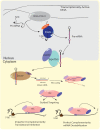MicroRNAs and their applications in kidney diseases
- PMID: 24928414
- PMCID: PMC4265577
- DOI: 10.1007/s00467-014-2867-7
MicroRNAs and their applications in kidney diseases
Abstract
MicroRNAs (miRNAs) are short, non-coding RNAs that employ classic Watson-Crick base-pairing to identify their target genes, ultimately resulting in destabilization of their target mRNAs and/or inhibition of their translation. The role of miRNAs in a wide range of human diseases, including those afflicting the kidney, has been intensely investigated. However, there is still a vast dearth of knowledge regarding their specific mode of action and therapeutic effects in various kidney diseases. This review discusses the latest efforts to further our understanding of the basic biology of miRNAs, their impact on various kidney diseases and their potential as novel biomarkers and therapeutic agents. We initially provide an overview of miRNA biology and the canonical pathway implicated in their biogenesis. We then discuss commonly employed experimental strategies for miRNA research and highlight some of the newly described state-of-the-art technologies to identify miRNAs and their target genes. Finally, we carefully examine the emerging role of miRNAs in the pathogenesis of various kidney diseases.
Figures


References
-
- Farh KK, Grimson A, Jan C, Lewis BP, Johnston WK, Lim LP, Burge CB, Bartel DP. The widespread impact of mammalian MicroRNAs on mRNA repression and evolution. Science. 2005;310:1817–1821. - PubMed
-
- Ambros V. The functions of animal microRNAs. Nature. 2004;431:350–355. - PubMed
-
- Kloosterman WP, Plasterk RH. The diverse functions of microRNAs in animal development and disease. Dev Cell. 2006;11:441–450. - PubMed
-
- Kennedy D. Breakthrough of the year. Science. 2002;298:2283. - PubMed
Publication types
MeSH terms
Substances
Grants and funding
LinkOut - more resources
Full Text Sources
Other Literature Sources
Medical

